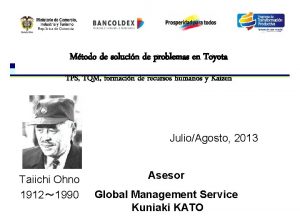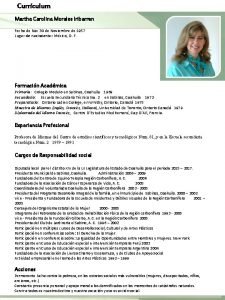LEADERSHIP AND MANAGEMENT Rosa y Justo Morales Leadership







































































- Slides: 71


LEADERSHIP AND MANAGEMENT Rosa y Justo Morales

Leadership and Management What’s in a Word?

Confusing Terms o. Leadership o. Is about coping with change (John P. Kotter) o. Doing the right things (Bennis) o. Management o. Coping with complexity (Kotter) o. Doing the right things (Bennis)

Confusing Terms o. Administration o. Supervision

Terms are Different, but Interrelated and Overlapping Administration Leadership Management Supervision

MANAGEMENT AND LEADERSHIP o Administers o Is a copy o Maintains o Focus: Systems & structure o Relies on control o Has short-range view o Asks “how” and “when” o Eye on the bottom-line o Imitates o Accepts the “status quo” o Is the classic “good soldier” o More left-brain thinking o And …”does things right” o Innovates o Is an original o Develops o Focus: people o Inspire trust o Has long-range perspective The Manager o Ask “what” and “why” o Eye on the horizon o Originates o Challenges the “status quo” o Is his/her own person o More right-brain thinking o And… “does the right things” The Leader

Activity (Balloon Towers) • Total group divides into smaller groups of 6 -8 people. • 2. Each group is given balloons and a roll of masking tape. • 3. The goal is to make a free standing tower (ie cannot attach off of ceiling, lean against wall, etc. )

5 Levels of Leadership: Proven Steps to Maximize Your Potential (John Maxwell)

PINNACLE PEOPLE DEVELOPMENT PRODUCTION PERMISSION POSITION

Skills of Effective Administrators/Leaders/Managers Robert L Katz Conceptual Skills Human Skills Technical Skills

Grouping Ideas • Name of Activity: Grouping Ideas • Time Needed: 5 - 15 minutes • Number of Players: No Limit • Materials Needed: None • Preparation Needed (Ahead of Time): None

Responsibility Who is responsible? And for what?

Responsibility Who is responsible? And for what?

Activity (Blindfolded Leader Game) • Everyone gets in a line and puts their hands on the shoulders of the person in front of them. • Everyone except the first person in line closes their eyes. The first person who is the leader leads everyone around, and the group has to communicate and work as a team to avoid obstacles.

Personality Type A In this theory, tend to be very driven, focused and goaloriented. These behaviors help Type As become successful at work. They may also be natural leaders, planners and participants in many different activities.

Personality Type B • They tend to be calm, patient individuals, planners by nature they rarely complain or stress about the outcome of those plans should they not fall just so. • Type B personalities are also tolerant and flexible when it comes to work and life situations. They easily adapt to change and consequently can kick bad habits sooner than their counterparts type A. Change is no big deal to a type B

Activity (Differences) • Instructions: • 1. Give each participant a sheet of paper and close your eyes and hold the paper in front of you. • 2. Fold the paper in half and in half again. Should form a triangle with the folded paper. • 3. Rip off the lower right corner. • 4. Open your eyes and unfold the paper.

Time Management Everyone has exactly the same number of hours in the same number of days in the same number of weeks and months. Because God made each person different, however, you will probably use those minutes, hours, and weeks differently than other people. Many of us need either instruction, review, or a renewal of time management, especially when we serve in leadership roles.

Procastinators • Procrastinators come in all types. Everyone has a little bit of the procrastinator inside. It often shows itself: • When you feel so overwhelmed you don’t know where to start. • When you have a job that you absolutely hate doing. • When someone stops by with a perfectly good reason why you should do something else. • When you’re tired and need a vacation.

Procastinators • How you procrastinate can be interesting. • “There is a time for everything, and a season for every activity under the heavens. ” Ecclesiastes 3: 1

Time Management Tips • Never handle anything twice when you can handle it once. • Set time limits on projects and stick to them. Be realistic. • Consider the importance of perfection versus getting the job done. • Determine what is important and what is urgent. • Set aside time to address things you have put off. • Outsource as much of your work as you can. • Make lists and prioritize.

Time Management Tips • Use email instead of telephone whenever possible. • Do the jobs you dislike most when you are fresh, not when tired. • Plan time into your schedule for interruptions, equipment breakdowns (the unpredictable) • Plan a specific cleanup day. It will help you feel organized.

Time Management Tips • Put things away as soon as you are finished with them. • Arrange your office (workroom) for minimum amount of movement, but take breaks to refresh yourself between or during heavier jobs. • Get proper rest and nourishment. Large quantities of food once a day or no meal at all will slow you down. • Take time to plan head—short-term and long-term.

Successful Meetings • 1. Know the purpose of the meeting. • 2. If you are chairing the meeting, send out an invitation and a written agenda in advance. • 3. Before each meeting, make sure you have the equipment and supplies you may need. • 4. Start on time; end on time. Let the agenda guide you without being a slave to it.

Successful Meetings § 5. Know the material you are presenting. Be confident with your words and actions. Keep to the point; no long stories. (Remember, God speaks through you!) • 6. Include opportunity for input from others, including a group -building activity and sharing time. • 7. Dress appropriately.

Successful Meetings • 8. If someone disagrees with you, listen well. Instead of treating it as a personal attack, think of it as improving what you’re already doing. Evaluate, get input from others, either act on it immediately or explain that you’ll want to think about it some more. Thank the person for the input. You don’t really want only “Yes people” on your team. • 9. Let your passion show, but keep cool. Take the high road—no whining, complaining, or negative words. • 10. Remember, prayer is powerful. Always invite God to attend the meeting with you and be your guide.

Budget and Events • Program: Children’s Ministries Year: Current • Resource Needs: Children’s Sabbath School Department: • 1. Publishing House Materials _______ • (To arrive at this figure, you will need to consider what is currently being spent by each division for papers, leaders’ guides, etc. and projected additional materials) • 2. Other _______ • (This would include other supplies, decorations, material from other publishers, audio/DVD, etc. )

Budget and Events Beginners _____ • Kindergarten • Primary • Juniors • Earliteens _____ • __________

Budget and Events • Equipment or Major Additions Needed • ____________________________________

Budget and Events • Equipment or Major Additions Needed • ____________________________________

Budget and Events Outreach Activities • Vacation Bible School _____ • Child Evangelism Meetings • Neighborhood Bible Clubs __________

Budget and Events Nurture Activities • Weekly Church Bulletins • Children’s Newsletter _____ • Baptismal Classes __________

Budget and Events Nurture Activities • Adventure Club _____ • Pathfinder Club _____ • Miscellaneous _____

Budget and Events Total Children’s Ministries Budget • Sabbath School _____ • Outreach Activities • Nurture Activities • Miscellaneous • Total Budget __________ _____

Organization of Event • Aim or goal of event: __________________ • Place, date, time: ____________________ • Budget: _______________________ • Transportation: _________ Admissions: _______ • Food: ____________ Lodging: ________ • Who is invited: ____________________

Organization of Event • Time and place of organizational meetings): __________________________ • __________________________ • Personnel and their responsibilities: • ______________________ • __________________ • 1) Promotion of event: _________________ • Resources needed: __________________

Organizing a Training • The Event: ________________ • Who’s responsible for what? __________ • Goal/logo: ________________ • Location, date, times: _____________ • The budget (Be sure to include honorariums): _______

Organizing a Training • Speakers / instructors / presenters: ____________ • Resources/supplies/gifts: _________________ • Music leader/ instrument/music: ______________ • Promotion: (who, when, how, where): ____________ • Logistics pertaining to the site: (chairs, tables, equipment): _____ • Time and place of meetings with those in charge of the various areas: __________________________

Organizing a Training • Handouts/programs: _________________________ • Registration: _____________________________.

Working with administrator Pastor, head elder, and finance committee chair. Of course other members of the church board, the other elders, deaconesses carry some administrative responsibilities as well.

ADDITIONAL INFORMATION

How to lead and management people • Catch people doing things right and then let them know that they are doing things right. • Use feedback to stay informed about what other people are doing in your area of responsibility and authority. • Have regular, focused meetings regarding the projects that you are responsible for. • Provide adequate instructions. Time is lost if things are not done correctly. • Train others to do jobs. You cannot do them all, nor can others do them if they have not been trained.

How to lead and management people • Expect others to succeed. It becomes a self-fulfilling prophecy when you believe others are loyal, dedicated and doing a good job. • Help others see how they will benefit from doing a job. This is when they truly become motivated. • Do not avoid talking to a poor performer. It hurts them, the organization and yourself if the situation is not dealt with. • Do not over control others. It is frustrating for them and time consuming for you. • Focus on results, not on activities or personalities.

How to lead and management people • Reward people for the results that they produce. • Manage by walking around. See what people are doing and listen to what they have to say. • Make quality an obsession, especially on smaller items. • Send thank you notes and memos. • Provide volunteers with open, direct, and immediate feedback on their actual performance as compared to expected performance and they tend to correct their own deficiencies.

How to lead and management people • Practice naive listening. Don't talk, just let people explain why they are doing the types of things that they are doing. You will learn many things. Manage by exception. When things are going well, leave them alone. When a problem occurs, then help. • Never seek to place blame. Always focus on the problem. • Never ignore a concern of one of your people. While it may seem trivial to you, to the other person it is a problem that will continue to destroy their train of thought. • Make it a personal rule and a challenge to respond to someone within 24 hours of hearing their request.

How to lead and management people • If you give volunteers a basic intruction, you will not be interrupted with their questions. • Pay attention to small details, the big ones are obvious and get taken care of. • Stay open in your thinking. Be open to all new ideas. Do this and you will not be setting up barriers that do not exist. • Avoid asking others to do trivial personal items for you. • Say thank you to those with whom you associate. • A warm smile and strong handshake break barriers.

How to lead and management people • Let people know why they are doing something. It then becomes more meaningful when they recognize their part in a greater vision. • Provide soft, lively background music not slow and not rock. • Practice the golden rule in business: Do unto others the way you would have them do unto you.

How to lead and management people • Practice the platinum rule in interpersonal relationships. It is "Do unto others, the way they want to be done unto. " They will be more apt to stay comfortable when interacting with us when we are able to do things their preferred way. • Get others to commit to deadlines by asking, "When can you have that for me? " • Nail down commitment by asking, "Do I have your word that you will have that for me then? " • Set the stage for cooperation from others by: 1) Introducing the idea; 2) Continual stimulation by talking about it; and 3) get others to make an investment by having them participate in the planning.

How to lead and management people • If you are unable to reach agreement or get a commitment from another person in a meeting, agree to disagree, but summarize your understanding in a confirming memo. • Giving people recognition generates energy within them. They will then direct that energy toward increased productivity. • Tap the potential of those working for you by giving them opportunities to think things through for themselves instead of just telling them how to do something. • Always give people the benefit of the doubt. They may not be the cause of a problem. The cause may be beyond their control.

How to lead and management people • Admit it when you do not know the answer to a question posed by a staff member. Then challenge the staff person to research and decide what the best answer is. It will help this person grow. • Be persistent and follow up. • When you were away and some of your people did an exceptional job, call them at home in the evening when you find out and personally thank them for what they did instead of waiting until the next time you see them.

How to lead and management people • If you know that a person will respond angrily to a particular comment, avoid bringing it up. It is nonproductive and bad for the relationship. In other words, "never kick a skunk. " • When you appreciate what someone has done, let them know and put it in writing. • Have an opinion survey done to determine how people view the Ministry. That way you can catch any problems while they are still small.

How to lead and management people • When asking someone to do something, let them know what is in it for them and the Ministry. Do not focus just on what is in it for the Ministry and yourself. • The director is the strongest model the volunteers have. Be a positive model as people are watching to see how you behave. They will reflect this in their own behavior. Lead by example. • Be seen as Fair, Firm, Friendly and having Foresight.

How to lead and management people • Do not help others unless they need and ask for help. • Encourage your people to come up with new ideas and ways to do things. Give them credit and recognition for the idea. • If a new idea won't work, at least praise the effort of the person so they will come up with future ideas. • Once a month meet with each volunteer to catch any problems or concerns the person may have as soon as possible before they become a crisis.

How to lead and management people • Be the kind of a person that others want to help out and work for. • Be flexible and do whatever it takes to get the job done. Remember it is results that count, not activities. • Generally speaking, getting something done perfectly is usually not as important as getting it done. Perfection has a high cost and it may not be worth it. • When giving or receiving information, don't hurry. Take the time needed to truly understand. It prevents future problems and misunderstandings.

How to lead and management people • Whenever you are having an important discussion with a person, before parting, set a specific follow-up date and time and write it in your calendar. • Never criticize an employee in front of others. Have all discussions of a corrective nature in private. • Hire people with specific skills and interests that match what the Ministry needs to have accomplished. The better the match, the better the productivity and the more motivated the person.

How to lead and management people • Treat people as people-not things. • Flaring in anger will drive others away. If not physically at least mentally, • Keep a "warm fuzzy" file for each person a place to keep track of the things you have already complimented them for, and want to compliment them for. • Have regular performance review and goal setting sessions with each of your volunteers regularly.

How to lead and management people • Low morale in volunteers may be an indication of the leader only talking about negative things or what's wrong. Be sure to balance negative comments with more frequent positive comments. • Let your people know you are there to help them not to harass them.

How to lead and management people • Form an action team to address people's problems right away rather than letting things drag out and perhaps get worse. • Instead of saying to another, "What can I do for you? " ask them "What can you do for me on this project? " • Do not hold back from discussing the need to improve performance with one of your people.

How to lead and management people • Encourage others to develop their plan of action and give you a detailed explanation. • Encourage individuals to compete against themselves to achieve more. Let it be a personal challenge to become better as an individual-not competing with others but self. • Check the ratio of positive comments to negative comments that you make to your people. Purposely make more positive comments.

How to lead and management people • Do things for others. They will be more willing to do things for you. • Set up an orientation training program for all new volunteers. • Stay informed of volunteers' needs and interests. Projects can be more effectively designed and rotated when you are well informed.

How to lead and management people • If individuals needs some encouragement in taking action, ask them, "What if. . . " questions to help them see what choices of action are available. • Let people know that you know they can do it. • Ask questions creatively so the action to be taken is suggested by the person who is to take it. • Set up incentives that reward desired performance.

How to lead and management people • Ask others for their estimate of how long it will take to do a project. When possible, agree and hold them accountable for that goal. • Take on someone else's routine so they can do what you need done without interruption. • Just as with family members, break large chores up into small, fun activities and enjoy doing them with team members.

How to lead and management people • Do not be quick to judge others. Learn to listen carefully before coming to conclusions. • Consider sharing ideas and responsibility with others rather than just getting someone to do it for you or just doing it yourself. • Inspire others to new levels of achievement by using positive encouraging feedback and ideas. • Don't just ask someone who is busy to get things done for you; look for the busy person who is getting results. This is a doer, not simply a busy wheel spinner.

How to lead and management people • Believe in the good of people. • Do not be a "baby sitter" of others, constantly taking care of them and telling them what to do. Challenge them and help them learn to think and do things for themselves. • Don't do what you can get someone else to do by simply asking. • Clearly communicate who you want to do what, by when and at what cost. Then identify who needs to know about it and when they are to be informed.

How to lead and management people • For people you relate to regularly, keep a list of things you need to talk to the person about. Then when you meet with or call them, you can review all the items that have accumulated on your list. • Recognize you are not the only one who can do a job right. Trust others to do things for you. • Organize, deputize, supervise.

How to lead and management people • Meditate for one minute before starting a new subject or project. • Don't worry about who gets the credit for completing a project. Focus on the task To be accomplished and do it. • When credit is given to you for completion of a project, be sure to give it to all who were involved. This will nurture the relationships and provide motivation to support you in the future.

How to lead and management people • Be sincerely interested in the people working for and with you. • Help others recognize their own importance. • Keep a list of birthdays, marriage and work anniversaries and other special dates. Provide recognition to your volunteer on each of these dates. Mark your calendar prior to the actual date so you have time to prepare for it.

bibliography Kotter P. John, On What Leaders really Do. Mar 18, 1999 Force For Change: How Leadership Differs from Management. Apr 1, 1990 • Accelerate: Building Strategic Agility for a Faster-Moving World. Apr 8, 2014 Leadership and the New Science: Discovering Order in a Chaotic World / Edition 3 15, 1999

bibliography Bennis G. Warren. On Becoming a Leader / Edition 4. 1994. Learning to Lead: A Workbook on Becoming a Leader / Edition 4. Apr 27, 2010 Transparency: How Leaders Create a Culture of Candor. May 30, 2008 Warren Bennis, Patricia Ward Biederman. Organizing Genius / Edition 1. 1994

bibliography • Katz L. Robert Skills of an Effective Administrator (Harvard Business Review Classics) May 7, 2009.
 Pastor justo morales
Pastor justo morales Rosangela rosa da rosa
Rosangela rosa da rosa Catedral de justo terminada
Catedral de justo terminada Escuela justo josé de urquiza
Escuela justo josé de urquiza Características de un hombre justo
Características de un hombre justo Caracteristicas del apostol santiago el menor
Caracteristicas del apostol santiago el menor Lo justo no es lo correcto
Lo justo no es lo correcto Dios no oye la oracion del pecador
Dios no oye la oracion del pecador Lo injusto
Lo injusto Justo puerto albandoz
Justo puerto albandoz Imagen positiva justo villafañe
Imagen positiva justo villafañe Dios es santo y justo
Dios es santo y justo Romero comercio justo
Romero comercio justo Profano es la polaridad de justo
Profano es la polaridad de justo Acordemos las reglas
Acordemos las reglas Pilares del sistema de producción toyota
Pilares del sistema de producción toyota Não sejas demasiadamente justo nem exageradamente sábio
Não sejas demasiadamente justo nem exageradamente sábio Estas justo a tiempo
Estas justo a tiempo Mercado justo fracaso
Mercado justo fracaso Es justo que subjuntivo o indicativo
Es justo que subjuntivo o indicativo Romero comercio justo
Romero comercio justo Ccusto justo
Ccusto justo Transactional vs transformational
Transactional vs transformational Sanford creek greenway
Sanford creek greenway Ivy morales
Ivy morales 5 valores morales
5 valores morales Francisco coll guitart
Francisco coll guitart Martine morales
Martine morales Catálogo de delitos de personas morales
Catálogo de delitos de personas morales Dilemas morales
Dilemas morales Miguel treviño morales
Miguel treviño morales Actualizacion de perdidas fiscales personas morales
Actualizacion de perdidas fiscales personas morales Castillo morales apareyi
Castillo morales apareyi Ejemplos normas morales
Ejemplos normas morales üpor
üpor Dilemas morales ejemplos
Dilemas morales ejemplos Dr carlos morales
Dr carlos morales Carolina morales iribarren
Carolina morales iribarren Ejemplos normas morales
Ejemplos normas morales Alejandra osuna morales
Alejandra osuna morales Jay lonewolf morales
Jay lonewolf morales Ceip luis casado
Ceip luis casado Sara morales vigo
Sara morales vigo Marcelo morales lattes
Marcelo morales lattes Atributos morales de dios para niños
Atributos morales de dios para niños Unit 1 generations
Unit 1 generations Cual es la importancia de la ética ministerial
Cual es la importancia de la ética ministerial Angela maria morales
Angela maria morales Fases en la discusión de dilemas morales
Fases en la discusión de dilemas morales Jerarquia de valores
Jerarquia de valores Carlos morales md
Carlos morales md Ejemplos de dilemas morales en la escuela
Ejemplos de dilemas morales en la escuela Escala de hunt y hess
Escala de hunt y hess Los atributos morales de dios
Los atributos morales de dios Características de los estándares morales
Características de los estándares morales Pedro francisco guerra morales
Pedro francisco guerra morales Disvalores que son
Disvalores que son Parque ernesto morales humacao
Parque ernesto morales humacao Hector garcia morales
Hector garcia morales Julio fierro morales
Julio fierro morales Dr ximena morales
Dr ximena morales Trazando el camino morales
Trazando el camino morales Martine morales
Martine morales Definición de planeación financiera
Definición de planeación financiera Cuadro comparativo de normas morales y juridicas
Cuadro comparativo de normas morales y juridicas Yesenia morales bungee jumping
Yesenia morales bungee jumping Negacin
Negacin Martinez morales
Martinez morales Fiona coll
Fiona coll Vacuna vph niñas
Vacuna vph niñas María mazzarello maddalena calcagno
María mazzarello maddalena calcagno Vih sintomas
Vih sintomas






























































































